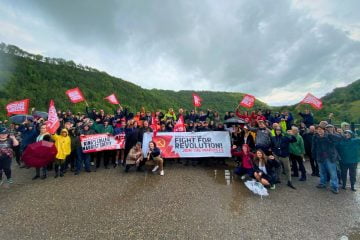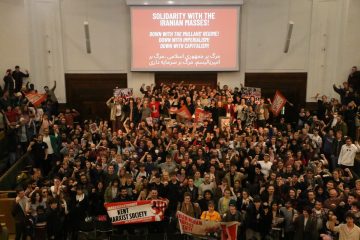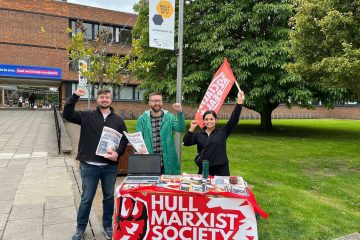Join the Marxist Student Federation at Revolution 2018, a three-day festival of Marxist ideas held at Student Central on 19-21 October! One of the many topics of discussion will be “Martin Luther King and the Black Struggle.” In preparation, we republish this important article on race and class.
“You can’t talk about solving the economic problem of the Negro without talking about billions of dollars. You can’t talk about ending the slums without first saying profit must be taken out of slums … we are treading in difficult water, because it really means that we are saying that something is wrong … with capitalism … There must be a better distribution of wealth and maybe America must move toward a democratic socialism.”
Martin Luther King, November 1966
Today [4 April 2008] marks 40 years since the assassination of Dr. Martin Luther King Jr., shot in the face on the 2nd floor balcony of the Lorraine Motel in Memphis, Tennessee. James Earl Ray was imprisoned for the assassination, though never granted a trial for his murder. Given the US government’s targeting of radicalised black leaders at this time, whoever pulled the trigger did the state’s dirty work for them. The King family never accepted Ray was responsible.
King rose to prominence in the Black movement when he became leader of the Montgomery bus boycott in Alabama in 1955. The boycott sought to wring vital concessions from the state, such as the dropping of the segregationist Jim Crow Laws, by flexing the economic muscle of the black working class that made up 2/3 of Montgomery bus passengers. Originally the leading church ministers in the community showed reservations in participating. The local president of the NAACP (National Association for the Advancement of Coloured Peoples), E.D. Nixon, who had organised the boycott, threatened to expose the ministers’ cowardice. The church was saved when King offered himself as leader.
Although black people had won formal independence from slavery following the American Civil War, almost a century later they remained in a socially inferior position. The working class, once split by racist propaganda, split politically too. The white workers, against the Republican party of triumphant big business, identified with the Democrats of the defeated South. The black workers cut adrift from the main current of the American working class, naturally identified with the Republican Party of Lincoln who had freed the slaves.
Craft union mentality in the US also hindered integrating black workers. Newly freed slaves emigrating to the urban North naturally entered on the bottom rung of the work force. A division between skilled and unskilled workers fighting for a larger slice of the pie was a feature of craft unionism. The entry of an unskilled black workforce alienated white unskilled workers by depressing their wages. But it also alienated skilled workers by strengthening the hand of the unskilled unions. As capital and its labour stooges sought to block industrial unity between black and white workers on the industrial front, so the aspirations of black workers eventually expressed themselves through community and single-issue organisations, like the NAACP, which made up the civil rights movement.
The history of the labour movement wasn’t a total black-and-white issue however. For example in Alabama, an area notorious for its deep-south mentality, the issue of unionising black workers in the mining industry at the beginning of the 20th century was met with severe resistance by local employers. The United Mine Workers, a union not so affected by a narrow craft outlook, fought long and hard in the area, and by 1948 had a 45% black membership. The miners even employed entryist tactics – when the Ku Klux Klan (local businessmen in sheets) started mobilising against black unionisation in the area, the white miners infiltrated it and rendered it impotent!
Martin Luther King went to lead the Montgomery bus boycott to victory, successfully led the battle against segregation and the March on Washington for Jobs and Freedom, where he made his famous ‘I have a dream speech’. As time went on many leaders of the civil rights movement, while making progress in highlighting the need for formal equality, didn’t address the deeper-rooted problem of black impoverishment. Opposition to the war highlighted the disproportionate amount of economic conscripts from non-white working class communities – just as we see today in Iraq – and radicalised the likes of King and Malcom X, bringing new militant elements into the movement, like the Black Panthers, who began to lean towards Marxism.
After the state moved to crush the new militancy in the black movement it was derailed into reformism, such as ‘positive discrimination’, which has certainly benefited a layer of the new black middle class. But the fact remains that black liberation is inseparable from the liberation of the working class as a whole.
This can only come through the segregation of humanity from capitalism, a system drenched in racism. As King said, “How long? Not long. Because no lie can live forever.”




0 Comments